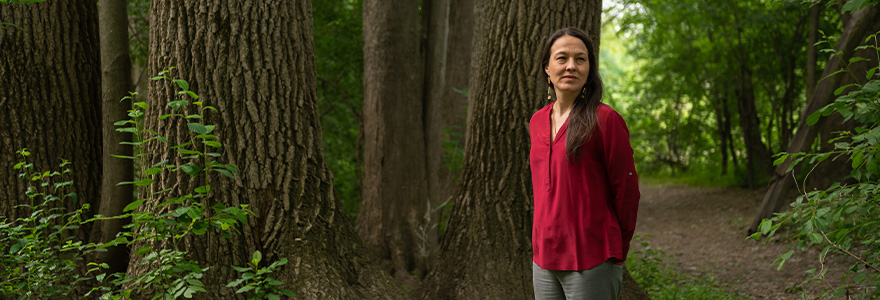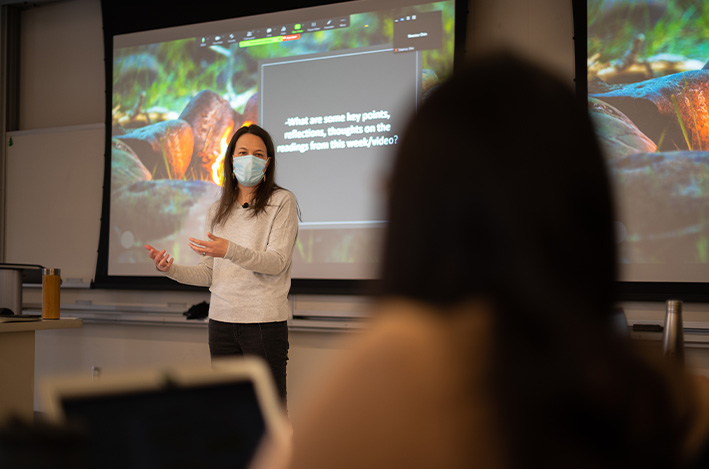Seeing with Two Eyes

Nicole Redvers brings an Indigenous perspective to the effects of climate change on our health.
The strawberries were ready in late June. Then, there’d be a break – more time for exploring – before the raspberries, then gooseberries, and finally the cranberries. As a Deninu Kųę First Nation child growing up in the ’80s in the Northwest Territories, Nicole Redvers may not have realized that the land was her teacher. But she knew hunting, trapping and harvesting medicines were part of life. And she knew summers were for picking berries with her kokum.
“It was one of my favourite things to do. I’d be out there in the bush with my grandma, probably eating more than picking,” said Redvers, associate professor and Western Research Chair and director in Epidemiology and Biostatistics and director of Indigenous Planetary Health.
“She would be leaned over for hours. My dad always worried a bear would come around and she wouldn’t even notice, but my grandma couldn’t care less. I always loved being out on the land with her.” Back then, harvesting seasons were predictable around the remote communities of Deninu Kųę (“Deneh-nookweh) and nearby Kátł’odeeche (KatLow-Dee-Chee) First Nations.
It’s different now.
Recent reports show Northern Canada warming at four times the global rate. But that’s not news to Indigenous Elders who’ve long been talking about signs of the climate crisis and how it is affecting the health of the planet and all living things.
“The ground is dry. The vegetation is changing and there are fewer animals. We’ve had drops in caribou… from climate change and from industry. Elders have been talking about these things for decades. That’s what started me on this track.”
—Nicole Redvers
“The ground is dry. The vegetation is changing and there are fewer animals. We’ve had drops in caribou… from climate change and from industry,” Redvers said. “Elders have been talking about these things for decades. That’s what started me on this track.”
***
Redvers’ role at Schulich Medicine is part of a global move by medical schools to include climate change in health education. The goal is to get graduates addressing the causes of health problems, rather than just learning to treat them.
“Medical and health students should be thinking about planetary health because everything is interconnected,” said Redvers, who is co-founder and past board chair of the Arctic Indigenous Wellness Foundation in Yellowknife and worked as a naturopathic doctor and global medical volunteer for more than a decade before turning to academia.
“We can treat something like asthma until the cows come home, but if we aren’t addressing the origins, for example, air pollution, it will continue putting a heavier burden on the health system.”
While Canada’s medical schools have agreed to add climate change to their curriculum, only Schulich Medicine & Dentistry includes a position focused on Indigenous worldviews in planetary health. It also has one of the few Master of Public Health (MPH) in Canada that requires an Indigenous Health course – all with Redvers at the helm.
“Her course is a big reason I went to Schulich Medicine & Dentistry for my Master’s,” said Gurleen Braich, a student in the MPH program. “I knew Indigenous communities face so many barriers to health care, but it was something I never learned about during my undergraduate journey. I was very happy, we’d be learning from an Indigenous scholar who came from an Indigenous community.”
Redvers partners with Elders or Indigenous communities for all research, and often cites their work in class. Focusing on strengths of Indigenous ways of knowing passed down by Elders, course topics include food systems, traditional plants as medicine and sustainable practices Indigenous communities have used to protect the environment.
Students study the strengths of Indigenous knowledge systems and ways of being that are healthy for the Earth and humans. They also explore government policies that create health disparities for Indigenous communities.
“Indigenous Health is inherently linked to planetary health because an Indigenous worldview puts the health of Mother Earth first,” Redvers said. “If the planet is healthy, humans can be healthy.”
***
Her teaching is based on a “Two-Eyed Seeing Approach,” coined by Mi’kmaq Elder Albert Marshall, which looks at issues through both Indigenous and Western-based perspectives. She asks students to reflect on where their knowledge comes from and consider ways people with other worldviews might see the same thing they are looking at.
“For every topic, she would emphasize there are two ways of seeing this,” said Jennifer Jones, a former student in Redvers’ class. “Every section of the course added layers to Western knowledge by bridging it with Indigenous knowledge and worldviews – like considering how actions will affect people seven generations into the future. In my opinion, if we had taken that approach 40 years ago, the world would be different now.”
With so much evidence proving standardized health systems don’t work for all, Redvers teaches her students to add context into every component of public health.
“We learned it’s OK to ask what specifically works for a specific community,” said Braich. “I think all doctors, nurses and other health professionals need this course to make sure they do no more harm.”

Before joining Schulich Medicine, Redvers helped develop a PhD program in Indigenous Health for the University of North Dakota School of Medicine and Health Sciences. There, most of her students were Indigenous, so she didn’t need to spend much time on colonization, or punishing government policies that have led to all sorts of health disparities. They knew.
But at Schulich Medicine, where most students are non-Indigenous and many are international, Redvers brought a more “global perspective” on the health issues and perspectives from Indigenous Peoples around the world.
“While there are diverse cultural differences in our societies, the marginalization and the experiences of colonialism are often very similar. The barriers are there. I’m trying to make those connections more apparent for students,” said Redvers.
“I don’t think anyone who took that course would forget what they learned. The lessons in Indigenous Health were transferrable to everything.”
—Jennifer Jones
“I don’t think anyone who took that course would forget what they learned,” said Jones. “The lessons in Indigenous Health were transferrable to everything.”
Throughout her life, Redvers has seen how modern structures and policies hurt Indigenous Peoples in ways that can’t be fixed in a hospital. It’s what drove her from the clinic and eventually to Schulich Medicine, with the goal of tackling the structural issues themselves.
“The stark marginalization and racism and inequities in our communities are obvious to those who provide services and support, but sometimes the broader society is blind to those issues,” she said. “Having Indigenous Health programs will create more folks out there who are able to deal with the structural issues from both a research and practice standpoint.”
***
“There’s not a day that goes by that I don’t think about my home,” Redvers said.
At the time of the interview, she was planning to take her daughters on holiday there to the Northwest Territories.
“Fingers crossed; we’ll see some raspberries.”








